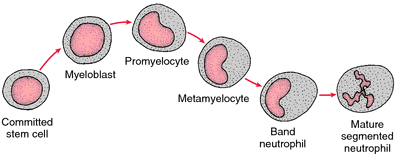neutrophil
(redirected from neutrophile)Also found in: Dictionary, Thesaurus, Encyclopedia, Wikipedia.
neutrophil
[noo´tro-fil]1. any cell, structure, or histologic element readily stainable with neutral dyes.

Neutrophil maturation. From Ignatavicius and Workman, 2002.
2. a granular leukocyte having a nucleus with three to five lobes connected by threads of chromatin, and cytoplasm containing very fine granules; called also polymorphonuclear leukocyte and neutrophilic leukocyte. See also heterophil.
band neutrophil band cell.
stab neutrophil band cell.
Miller-Keane Encyclopedia and Dictionary of Medicine, Nursing, and Allied Health, Seventh Edition. © 2003 by Saunders, an imprint of Elsevier, Inc. All rights reserved.
neu·tro·phil
, neutrophile (nū'trō-fil, -fīl),1. A mature white blood cell in the granulocytic series, formed by myelopoietic tissue of the bone marrow (sometimes also in extramedullary sites), and released into the circulating blood, where they normally represent 54-65% of the total number of leukocytes. When stained with the usual Romanowsky-type dyes neutrophils are characterized by a nucleus dark purple-blue nucleus, lobated (three to five distinct lobes joined by thin strands of chromatin), with a rather coarse network of fairly dense chromatin; and a cytoplasm that is faintly pink (sharply contrasted with the nucleus) that contains numerous fine pink or violet-pink granules, that is, not acidophilic or basophilic (as in eosinophils or basophils). The precursors of neutrophils, in order of increasing maturity, are: myeloblasts, promyelocytes, myelocytes, metamyelocytes, and band forms. Although the terms neutrophilic leukocytes and neutrophilic granulocytes include younger cells in which neutrophilic granules are recognized, the two expressions are frequently used as synonyms for neutrophils, which are mature forms unless otherwise indicated by a modifying term, such as immature neutrophil.
See also: leukocyte, leukocytosis.
See also: leukocyte, leukocytosis.
2. Any cell or tissue that manifests no special affinity for acid or basic dyes, that is, the cytoplasm stains approximately equally with either type of dye.
[neutro- + G. philos, fond]
Farlex Partner Medical Dictionary © Farlex 2012
neutrophil
(no͞o′trə-fĭl′, nyo͞o′-)adj.
Not stained strongly or definitely by either acid or basic dyes but stained readily by neutral dyes. Used especially of white blood cells.
n.
A neutrophil cell, especially an abundant type of granular white blood cell that is highly destructive of microorganisms.
neu′tro·phile′ (-fīl′), neu′tro·phil′ic (-fĭl′ĭk) adj.
The American Heritage® Medical Dictionary Copyright © 2007, 2004 by Houghton Mifflin Company. Published by Houghton Mifflin Company. All rights reserved.
neutrophil
A phagocytic WBC, normally constituting 60-70% of circulating WBCs. See Band, Dysplastic neutrophil, Hypersegmented neutrophil, Polymorphonuclear neutrophil.McGraw-Hill Concise Dictionary of Modern Medicine. © 2002 by The McGraw-Hill Companies, Inc.
neu·tro·phil
, neutrophile (nū'trō-fil, -fīl)1. A mature white blood cell in the granulocytic series, formed by bone marrow and released into the circulating blood, where neutrophils normally represent from 54 to 65% of the total number of leukocytes in a differential. When stained, neutrophils are characterized by: 1) a nucleus that is dark purple-blue and lobated; 2) a cytoplasm that is faintly pink and contains numerous fine pink or violet-pink granules. The precursors of neutrophils in order of increasing maturity, are: myeloblasts, promyelocytes, myelocytes, metamyelocytes, and band forms.
See also: leukocyte, leukocytosis
See also: leukocyte, leukocytosis
2. Any cell or tissue that manifests no special affinity for acid or basic dyes, i.e., the cytoplasm stains approximately equally with either type of dye.
[neutro- + G. philos, fond]
Medical Dictionary for the Health Professions and Nursing © Farlex 2012
neutrophil
, neutrophile (noo'tro-fil?, nu') (-fil?) [ neutro- + -phile],NE
A granular white blood cell (WBC), the most common type (55% to 70%) of WBC. Neutrophils are responsible for much of the body's protection against infection. They play a primary role in inflammation, are readily attracted to foreign antigens (chemotaxis), and destroy them by phagocytosis. Neutrophils killed during inflammation release destructive enzymes and toxic oxygen radicals that eradicate infectious microorganisms. An inadequate number of neutrophils (neutropenia) leaves the body at high risk for infection from many sources and requires protective precautions on the part of health care workers. Cancer patients receiving chemotherapy, which destroys leukocytes, must be carefully protected from infections during the course of therapy and until the bone marrow produces additional leukocytes.
As part of a severe inflammatory response or autoimmune disorder, neutrophils may begin attacking normal cells and cause tissue damage. This occurs in adult respiratory distress syndrome, inflammatory bowel disease, myocarditis, and rheumatoid arthritis. Corticosteroids are the most commonly used drugs to minimize the damage caused by severe inflammation. Synonym: neutrophilic leukocyte See: illustration; blood for illus.
polysegmented neutrophil
Polymorphonuclear leukocyte.illustrationMedical Dictionary, © 2009 Farlex and Partners
neutrophil
A white blood cell of the granulocyte group, with a multilobed (polymorph) nucleus and numerous granules in the CYTOPLASM that stain neither red with eosin nor blue with basic dyes. Neutrophils are the major circulating PHAGOCYTES of the granulocyte group. Compare EOSINOPHIL and BASOPHIL.Collins Dictionary of Medicine © Robert M. Youngson 2004, 2005
neutrophil
the most common type of white blood cell (LEUCOCYTES) formed in the bone marrow and with a normal count in human blood of between 2500 and 7500 cells per mm3. They have lobed nuclei and granular cytoplasm. Neutrophils are PHAGOCYTES, and are important in combating bacterial infections.Collins Dictionary of Biology, 3rd ed. © W. G. Hale, V. A. Saunders, J. P. Margham 2005
Neutrophil
The primary type of white blood cell involved in inflammation. Neutrophils are a type of granulocyte, also known as a polymorphonuclear leukocyte.
Gale Encyclopedia of Medicine. Copyright 2008 The Gale Group, Inc. All rights reserved.
neu·tro·phil
, neutrophile (nū'trō-fil, -fīl)A mature white blood cell in granulocytic series, formed by myelopoietic tissue of bone marrow and released into circulating blood.
[neutro- + G. philos, fond]
Medical Dictionary for the Dental Professions © Farlex 2012
